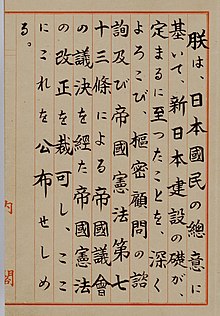| Constitution of Japan | |
|---|---|
 Preamble of the Constitution | |
| Overview | |
| Original title | 日本国憲法 |
| Jurisdiction | Japan |
| Presented | 3 November 1946 |
| Date effective | 3 May 1947 |
| System | Unitary parliamentary constitutional monarchy[1] |
| Government structure | |
| Branches | Three |
| Head of state | None[a] |
| Chambers | Bicameral (National Diet: House of Representatives, House of Councillors) |
| Executive | Cabinet, led by a Prime Minister |
| Judiciary | Supreme Court |
| Federalism | Unitary |
| History | |
| First legislature | |
| First executive | 24 May 1947 |
| First court | 4 August 1947 |
| Amendments | 0[3] |
| Location | National Archives of Japan |
| Author(s) | Milo Rowell, Courtney Whitney, and other US military lawyers working for the US-led Allied GHQ; subsequently reviewed and modified by members of the Imperial Diet |
| Signatories | Emperor Shōwa |
| Supersedes | Meiji Constitution |
| Full text | |
| This article is part of a series on |
 |
|---|
|
|
The Constitution of Japan[b] is the supreme law of Japan. It was written primarily by American civilian officials working under the Allied occupation of Japan after World War II. The current Japanese constitution was promulgated as an amendment of the Meiji Constitution of 1890 on 3 November 1946 when it came into effect on 3 May 1947.[4]
The constitution provides for a parliamentary system of government and guarantees certain fundamental human rights. In contrast to the Meiji Constitution, which invested the Emperor of Japan with supreme political power, under the new constitution the Emperor was reduced to "the symbol of the State and of the unity of the people" and exercises only a ceremonial role acting under the sovereignty of the people for constitutional monarchy.[5]
The constitution, also known as the MacArthur Constitution,[6][7] "Post-war Constitution" (戦後憲法, Sengo-Kenpō), or the "Peace Constitution" (平和憲法, Heiwa-Kenpō),[8] was drafted under the supervision of U.S. General Douglas MacArthur, the Supreme Commander for the Allied Powers, during the post-war Allied occupation of Japan.[9] Japanese scholars reviewed and modified it before adoption.[10] It changed Japan's previous system of semi-constitutional monarchy and stratocracy with a parliamentary monarchy. The Constitution is best known for Article 9, by which Japan renounces its right to wage war and maintain military forces.[11] Despite this, Japan retains de facto military capabilities in the form of the Self-Defense Forces and also hosts a substantial American military presence.
The Japanese constitution is the oldest unamended constitution in the world. At roughly 5,000 words it is a relatively short constitution, less than a quarter the length of the average national constitution.[3][12]
- ^ a b Kristof, Nicholas D. (12 November 1995). "Japan's State Symbols: Now You See Them ..." The New York Times. Retrieved 5 October 2019.
- ^ Kakinohana, Hōjun (23 September 2013). 個人の尊厳は憲法の基一天皇の元首化は時代に逆行一. Japan Institute of Constitutional Law (in Japanese). Archived from the original on 25 October 2019. Retrieved 25 October 2019.
- ^ a b "The Anomalous Life of the Japanese Constitution". Nippon.com. 15 August 2017. Archived from the original on 11 August 2019. Retrieved 11 August 2019.
- ^ Goes into Effect, New Japanese Constitution. "May 3, 1947, New Japanese Constitution goes into effect". www.history.com. History.com Editors. Retrieved 4 May 2022.
- ^ Takemae 2002, pp. 270–271.
- ^ Kawai, Kazuo (1958). "The Divinity of the Japanese Emperor". Political Science. 10 (2): 3–14. doi:10.1177/003231875801000201.
- ^ "The American Occupation of Japan, 1945-1952". Columbia University.
- ^ Kapur 2018, p. 11.
- ^ Moritsugu, Ken (18 August 2016). "Biden's remark on Japan Constitution raises eyebrows". AP News. Retrieved 10 August 2019.
- ^ Kapur 2018, p. 9.
- ^ Ito, Masami, "Constitution again faces calls for revision to meet reality Archived 8 November 2019 at the Wayback Machine", Japan Times, 1 May 2012, p. 3.
Cite error: There are <ref group=lower-alpha> tags or {{efn}} templates on this page, but the references will not show without a {{reflist|group=lower-alpha}} template or {{notelist}} template (see the help page).